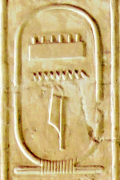Narmer: First Uniter of Egypt
Many people in Egypt lived in the north, known as Lower Egypt; many other people lived in the south, known as Upper Egypt. The northern lands were known as Lower Egypt because of their association with the mouth of the Nile River, which originated in the south (Upper Egypt) and ran northward to the Mediterranean Sea (through Lower Egypt). Lower Egypt, the area closer to the Mediterranean Sea, was more rural and more filled with agricultural fields. Upper Egypt was more urban, with cities such as Hierakonpolis, Naqda, and Thinis. 
The Narmer Palette, a two-sided stone tablet, still exists and illustrates the accomplishments of the ancient king, including depictions of him wearing the crowns of both Upper Egypt and Lower Egypt. On one side of the tablet, Narmer is shown wearing the White Crown of Upper Egypt; on the other side of the tablet, he is shown wearing the Red Crown of Lower Egypt. The depiction of this one king wearing both crowns has long been taken to mean that the king ruled both lands. A common reference to pharaohs throughout the history of Ancient Egypt was "Lord of the Two Lands." 
Archaeologists have found other pottery shards containing Narmer's name across North Africa and in the Middle East. A kings list found in tombs of later pharaohs also lists Narmer as the first pharaoh. One feat ascribed to Narmer is the founding of Memphis, at the mouth of the Nile Delta; this city was long a capital of Egypt. He is also credited with advancing trade with neighboring civilizations and with mandating large building projects. Some sources identify Narmer as a warrior king. Some hieroglyphs depict him as a catfish, smiting his enemies (a common method of depiction for pharaohs). Whether he engaged in the fighting, Narmer is known to have led armies into battle against neighboring Canaan and Nubia. Narmer is also sometimes referred to as Menes. Some sources start the kings list of Ancient Egypt with Menes; other sources say that Narmer preceded Menes, meaning that they were two different men. Many historians now think that Menes was a title and not a name. The name Menes means "he who endures." Unlike many of his successors, Narmer ordered a relatively small and ordinary tomb for himself. Archaeologists found this tomb in Umm el-Qa'ab. On either side have been found the tombs of Ka, whom many historians regard as Narmer's predecessor, and Hor-Aha, widely thought to be his successor. |
|
Social Studies for Kids
copyright 2002–2025
David White



 Narmer is thought to have been the first king to unite all of Egypt under his sway. He is thought to have lived in the 32nd Century B.C.
Narmer is thought to have been the first king to unite all of Egypt under his sway. He is thought to have lived in the 32nd Century B.C.
